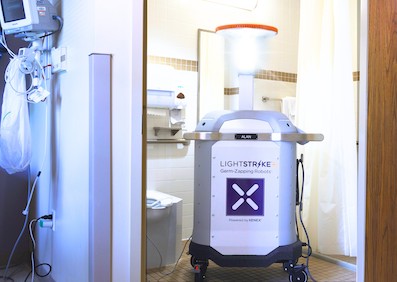 Cleanzine: your weekly cleaning and hygiene industry newsletter 3rd July 2025 Issue no. 1169
Cleanzine: your weekly cleaning and hygiene industry newsletter 3rd July 2025 Issue no. 1169
Your industry news - first
The original and best - for over 20 years!
We strongly recommend viewing Cleanzine full size in your web browser. Click our masthead above to visit our website version.
LightStrike UV robots eliminated superbug contamination in Japanese hospital reports new peer-reviewed study
 Researchers from Hiroshima University Hospital in Hiroshima, Japan, recently published a study confirming the efficacy of LightStrike pulsed xenon ultraviolet (UV) light disinfection technology on surfaces contaminated with the superbug vancomycin-resistant Enterococci (VRE).
Researchers from Hiroshima University Hospital in Hiroshima, Japan, recently published a study confirming the efficacy of LightStrike pulsed xenon ultraviolet (UV) light disinfection technology on surfaces contaminated with the superbug vancomycin-resistant Enterococci (VRE).
This is the 45th peer-reviewed and published study validating Xenex Disinfection Services' patented pulsed xenon UV room disinfection technology, and the third published study verifying LightStrike's efficacy against VRE, a deadly pathogen that can live on hospital surfaces for days to weeks.
While the world's attention has been focused on Covid-19 in recent months, hospitals continue to struggle with pathogens like Clostridioides difficile, VRE and Candida auris that lurk on surfaces and can cause healthcare associated infections. This most recent study provides further validation that using Xenex's LightStrike robot should be a priority and a critical part of a hospital's decontamination strategy because of the dangerous pathogens in the hospital environment that pose a risk to patients and healthcare workers.
‘The effect of pulsed-xenon ultraviolet disinfection on surfaces contaminated with vancomycin-resistant Enterococci in a Japanese hospital’ is published in The Journal of Infection and Chemotherapy (JIC), the official journal of the Japanese Society of Chemotherapy and The Japanese Association for Infectious Diseases.
According to the new study, researchers sampled numerous surfaces (toilet seat, toilet assist bar, bedrail, over-bed table, TV remote control, sink counter, etc.) in rooms that had been occupied by patients colonised with VRE before and after traditional manual cleaning, and then after disinfection with LightStrike pulsed xenon UV robots. The study showed that VRE was still present on surfaces in the patient rooms after manual cleaning, but there was no VRE remaining after LightStrike disinfection.
LightStrike Germ-Zapping Robots use pulsed xenon to create intense bursts of broad spectrum UV light that quickly destroys bacteria and viruses. Viruses and bacteria are vulnerable to UV light at different wavelengths, so the LightStrike robot deactivates them at the wavelengths where they are most susceptible. The robots don't require warm-up or cool-down time, and each robot can disinfect dozens of rooms per day. A peer-reviewed study validated that the robots are proven effective at destroying SARS-CoV-2, the virus that causes Covid-19.
With the fast-growing number of people hospitalised with Covid, healthcare facilities are focused on removing the deadly pathogens in their facilities. "Deadly pathogens like VRE and Candida auris are a global problem,” says Dr Mark Stibich, co-founder and chief scientific officer of Xenex. “As Xenex expands around the world, it's comforting to see that our technology can easily adapt to different configurations and workflows within healthcare facilities.
"This study validates other research, which has shown that less than half the surfaces in a patient room are properly disinfected when it's being prepared for the next patient. Pulsed xenon UV disinfection reduces the risk of pathogen transmission to healthcare providers and patients because the robot destroys pathogens like VRE before they can be transmitted to a person."
2nd September 2021







